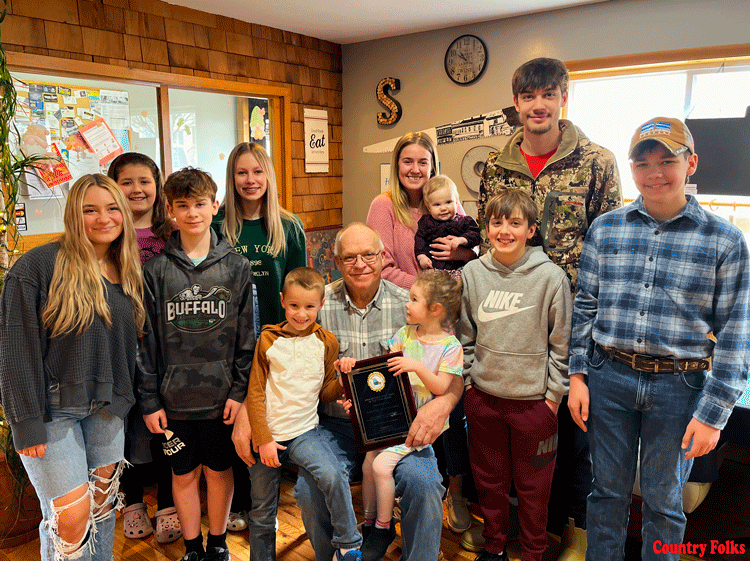 by Sally Colby
by Sally Colby
Alex and Becky Johnk are totally immersed in agriculture, from what they do every day on their farm to their participation in farm-related organizations.
The young couple planned their Greenville, NY farm to be diversified. Alex realizes the concept is a bit old-school, but he’s modeling the farm after a 1950s style farm with relatively small numbers of several different species.
“It’s a good way to hedge the farm’s profitability,” he said. “If something is down, something else might be picking the profits back up so you can keep the farm running.”
Right now, the farm is home to about 20 cows, both dairy and beef. The cows are dry now, but will be calving in a few months. “We did a lot of planning months in advance,” said Alex. “It’s primarily Becky and I on the farm, and we get quite a bit of help from Becky’s parents.”
The dairy cows are Holsteins and Guernseys, but the plan for the future is to phase out the Holsteins and focus on a purebred Guernsey herd. “Becky started raising Guernseys in high school and fell in love with them then,” said Alex. “She’s had a passion for them ever since.”
The beef cows are mostly crossbreds, the offspring of dairy cows bred A.I. to beef breeds to bring more Angus and Hereford bloodlines into the herd. The Holstein and crossbred cows are bred to beef sires, and any heifers retained in the herd will be bred back to beef bulls. Alex hopes to eventually build a beef herd of 20 cow-calf pairs to provide a steady supply of finished animals for market.
The Johnks also raise pigs, and currently have 12 sows. About half the sows are purebred Berkshires and the rest are Yorkshire x Berkshire crosses. Alex says although he started out raising Yorkshires, the market for piglets dries up in the fall. “A few years ago, I decided to branch out into Berkshires,” he said. “I saw the demand and potential for them, and thought it would be a good niche market for us. But I’ve found it can be a challenge to raise them. They have excellent meat quality, but litter sizes are small. I can get more for a piglet, but if the sow is having half as many piglets, my bottom line isn’t improving. I’ve taken the Yorkshire sows I started the herd with, bred them to Berkshires and kept the offspring. I’m getting nice meat quality and the litter sizes are increasing.”
Alex keeps two boars, and usually raises or purchases a new boar every year. “At any given time, my boar is no more than two or three years old,” he said. “I try to raise all of my own females from within my own herd, so I’ll go buy a new boar from time to time. It’s a good way to continually improve the herd genetics.”
Sows are kept in a pasture with free access to shelter, except during severe winter temperatures when they’re kept inside. Since Alex is on a processing schedule with a USDA plant, he finishes the pigs on grain so he can maintain that schedule.
Although Alex’s original goal was to sell piglets, he has been able to finish pigs for more profit. “Four years ago we marketed two pigs,” said Alex. “That was to family and family friends. Last year we did 24 pigs, both halves and wholes and also for the farmers’ market. My goal for this year is to do 40.”
This past summer, the Johnks had 350 laying hens, but cut back to 50. Alex says maintaining a higher number of hens wasn’t worth the effort for the return on eggs. “The hardest part was finding reliable, steady customers,” he said. “A lot of people want one or two dozen eggs a week, but when we’re getting 200 eggs a day, it’s hard to find a bulk customer.” The Johnks found that selling eggs at a farmers’ market was fairly profitable.
“This was the first year we did farmer’s markets,” said Alex. “It was a way to sell excess eggs, and a way for us to get our farm name out there. We tried two different markets, and had great success at one and poor results at the other.” Alex says the Coxsackie Farmers Market, where they had success, is held once a week for 20 weeks and maintains a very active marketing campaign with updates on social media. “We were the new people in town at a well-established market,” he said. “But once people started trying things, we saw the same customers coming back week after week.”
One of the Johnks’ long-term goals, hopefully within the next few years, is to open a raw milk dairy. Part of their plan includes installing a small-scale, on-farm bottling plant. Becky has been diligent in selecting A2A2 Guernsey heifers, which will produce milk that some consumers believe is a healthier option. “It will be a big initial investment, but we think it will be successful,” said Alex, explaining plans for the dairy. “We toured one farm in Vermont that had a simple set-up, and our plan is to tour a few more in New York because the regulations are different here.” The Johnks hope to milk about 15 cows once they obtain the necessary permits.
Both Alex and Becky are passionate about helping young people who are interested in learning about livestock. They offer an animal share program for 4-Hers who don’t live on farms, and for the past several summers have hosted and helped 4-Hers. “They come to our farm throughout the summer,” said Alex. “The last few years they’ve showed pigs and rabbits. This coming year we’ll have two young ladies working with our dairy heifers, and we have a waiting list of five kids who are interested in showing pigs.”
Alex is president of the Greene County Youth Fair and Becky is a board member, and both are active in Farm Bureau. Becky has served on the Farm Bureau county board of directors for 12 years, and is also the district representative for the Young Farmer and Rancher state committee. Alex has served as a county delegate at the Farm Bureau annual state meeting, and was recently elected to serve a one-year term on the state board.
“There are a lot of young members who are interested in Farm Bureau,” said Alex. “We’re seeing a lot more delegates who are 35 or under who are up front, voicing their opinions. We’re seeing more young people taking an active interest.”
Catch up with the latest news at Johnk Family Farm on Facebook.











Leave A Comment